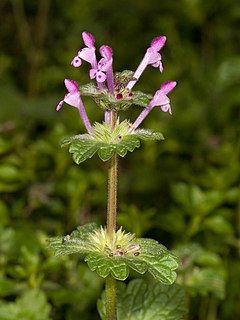
Lamium amplexicaule, commonly known as common henbit, or greater henbit, is a species of Lamium native to Europe, Asia and northern Africa.

Downingia bella, also known as Hoover's calicoflower or Hoover's Downingia, is a member of the Bellflower Family (Campanulaceae). The genus is named after A.J. Downing (1815–1852) a noted American horticulturist and landscape architect.
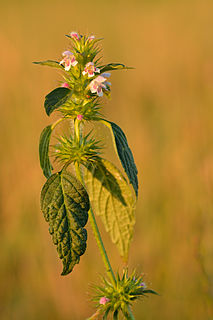
Galeopsis tetrahit, the common hemp-nettle or brittlestem hempnettle, is a flowering plant in the family Lamiaceae, native to Europe and northwestern Asia.

Downingia is a genus of 13 annual plants native to western North America and Chile. Commonly known as calico flowers, they are notable for forming mass displays of small but colorful blooms around vernal pools. A number are uncommon endemics in California.

Salvia pratensis, the meadow clary or meadow sage, is a species of flowering plant in the family Lamiaceae, native to Europe, western Asia and northern Africa. The Latin specific epithet pratensis means "of meadows", referring to its preferred habitat. It also grows in scrub edges and woodland borders.

Stachys sylvatica, commonly known as hedge woundwort, whitespot, or sometimes as hedge nettle, is a perennial herbaceous plant growing to 80 cm (31 in) tall in woodland and unmanaged grassland. In temperate zones of the northern hemisphere it flowers in July and August. The flowers are purple. The leaves, when crushed or bruised, give off an unpleasant fetid smell.

Downingia bacigalupii is a species of flowering plant in the bellflower family (Campanulaceae) known by the common name Bach's calicoflower or Bacigalupi's downingia. This showy wildflower is native to the western United States from California to Idaho, where it is a resident of moist meadows and vernal pool ecosystems. This annual grows on a branching erect stem with small diamond-shaped leaves at intervals. At the top of each stem branch is one or more flowers, each between one and two centimeters wide. The flower has two long upper lobes which may be flat and straight or curl back, and are usually dark-veined blue. The three lower lobes are fused into one three-toothed surface, which is dark-veined blue with two bright yellow blotches rimmed with white in the center. The fruit is a dehiscent capsule two to five centimeters long. The stamens are fused together into an erect purple stalk bearing the dark anthers.
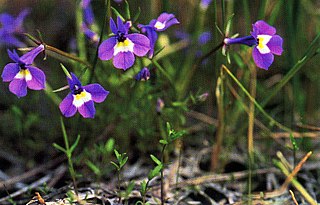
Downingia bicornuta is a species of flowering plant in the bellflower family known by the common name doublehorn calicoflower and double-horned downingia. This showy wildflower is native to the western United States from California to Idaho, where it is a resident of lakesides and vernal pool ecosystems.

Downingia concolor is a species of flowering plant in the bellflower family known by the common names maroonspot calicoflower and fringed downingia. This showy wildflower is endemic to California, where it is a resident of ponds and vernal pool ecosystems in the northern part of the state.
Downingia cuspidata is a species of flowering plant in the bellflower family known by the common name toothed calicoflower. This showy wildflower is native to California, where it is a resident of ponds, meadows, and vernal pool ecosystems throughout the state. Its range may extend into Mexico.
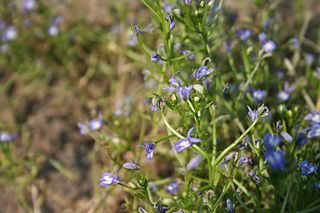
Downingia elegans is a species of flowering plants in the bellflower family known by the common names elegant calicoflower and Californian lobelia. This showy wildflower is native to western North America from California to British Columbia, where it is a resident of meadows and vernal pool ecosystems. This annual grows on a branching erect stem with many pointed leaves. At the top of each stem branch is one or more flowers, each one half to two centimeters wide. The tubular flower has two long, narrow, pointed upper lobes which are generally rich purple. The lower lip is fused into one three-lobed surface, which is purple with a large blotch of white in the center. The lobes may be quite pointed. There is sometimes some yellow coloration near the mouth of the tube.
Downingia insignis is a species of flowering plant in the bellflower family known by the common names harlequin calicoflower and cupped downingia. This showy wildflower is native to the western United States from California to Idaho, where it is a resident of lakesides and vernal pool ecosystems.
Downingia laeta is a species of flowering plant in the bellflower family known by the common name Great Basin calicoflower. This showy wildflower is native to western North America from California to Saskatchewan, where it is a resident of riverbanks, ponds, and vernal pool ecosystems. This annual grows on a thick erect stem with a few short, pointed leaves. Atop the stem is usually a single flower, which has an upper lip made up of two narrow, pointed lobes in shades of very light blue or purple, or white, and a lower lip which is a fusion of three lobes in the same color with two bright yellow spots and sometimes some purple or pink blotches or streaking.
Downingia montana is a species of flowering plant in the bellflower family known by the common name Sierra calicoflower. This showy wildflower is native to California, where it lives in the meadows and pine forests of the high mountains. Its range may extend into Oregon. This annual grows an erect stem, which may branch or not, with a few sparse small, pointed leaves. Atop the stem is usually one tubular flower. The upper lip is made up of two narrow, pointed lobes usually a shade of lavender, and the lower lip is the same color, with a central field of white and two prominent projections which may be colored yellow and dark purple. The lower lip has three lobes, each of which may have a tooth. The fruit is a capsule one to four centimeters long.

Downingia pulchella is a species of flowering plant in the bellflower family known by the common names flatface calicoflower and valley calicoflower. This showy, annual wildflower is endemic to California, where it is a resident of vernal pools and other wet places in the central part of the state from the Tehachapi Mountains to the San Francisco Bay Area.

Porterella is a monotypic genus of flowering plants in the bellflower family containing the single species Porterella carnosula, which is known by the common name fleshy porterella, or simply porterella.

Bartsia alpina is a species of perennial flowering plant, known by the common name alpine bartsia or velvetbells. It is found in the mountainous regions of Europe and also occurs in Iceland, Greenland and north‐eastern Canada.
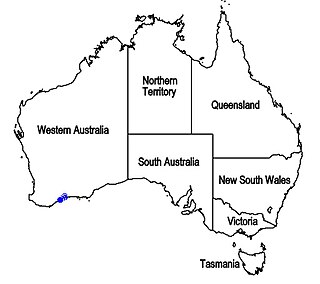
Hemiphora exserta is a flowering plant in the mint family Lamiaceae and is endemic to the south-west of Western Australia. It is a sprawling shrub with its branches densely covered with white, woolly hairs. Its leaves are rough and wrinkled and the flowers are deep pink or dark red, curved and tube-shaped with spreading petal lobes on the end.
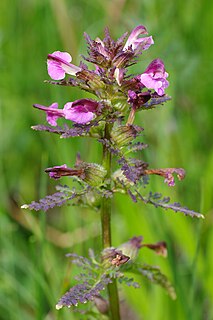
Pedicularis palustris, commonly known as marsh lousewort or red rattle, is a plant species in the family Orobanchaceae. It is native to central and northern Europe and Asia where it grows in wetlands and boggy habitats. The International Union for Conservation of Nature has assessed its conservation status as being of least concern.
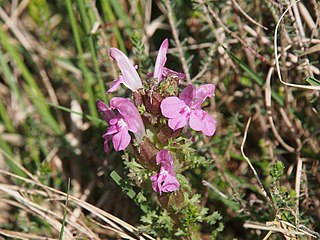
Pedicularis sylvatica, commonly known as common lousewort, is a plant species in the genus Pedicularis. It is native to central and northern Europe where it grows on moist acidic soils, moorland, grassy heathland and the drier parts of marshes.















